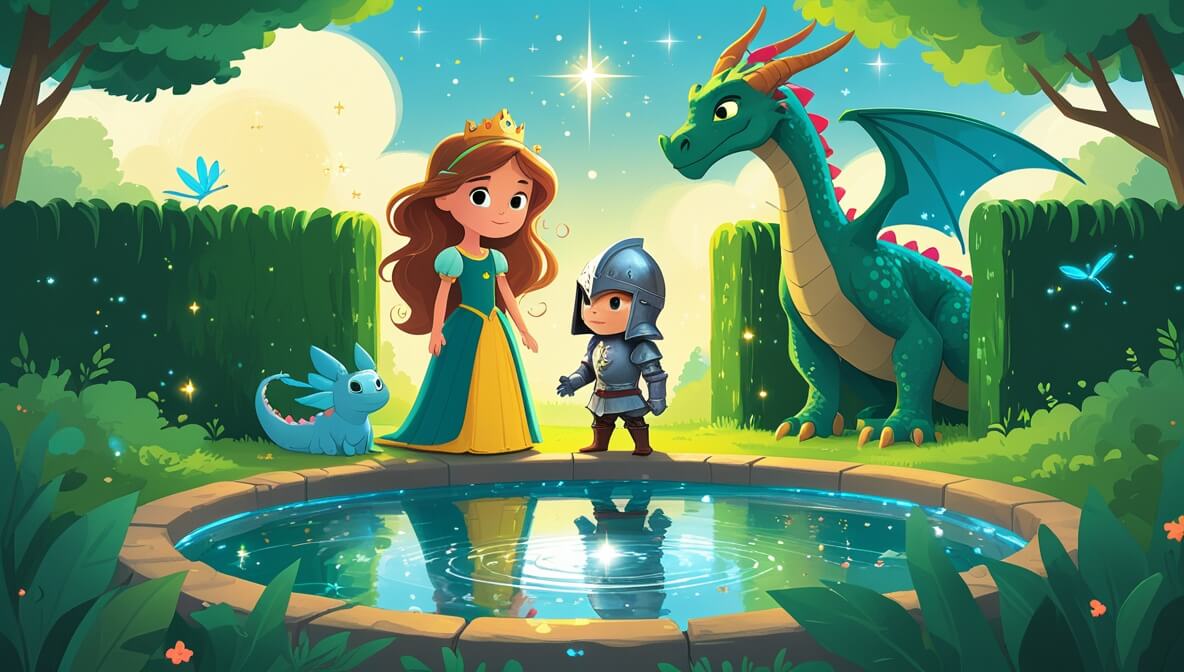In a magical kingdom, a young princess discovers a secret labyrinth guarded by a dragon. With courage and a magical mirror, she embarks on an adventure to uncover its mysteries.
Age Recommendation
3 – 12 years
Characters
Characters:
- Princess Celestia (a brave and curious young princess)
- Sir Gallant (a loyal and courageous knight)
- Dragon Ember (a misunderstood guardian of the labyrinth)
- Wise Willow (a fairy godmother with a magical mirror)
Story
Once upon a time, in the kingdom of Luminara, there lived a young princess named Celestia. Unlike other princesses, Celestia had a thirst for adventure and often dreamed of exploring the hidden corners of her enchanted kingdom. One day, while wandering in the castle’s grand library, she stumbled upon an ancient map revealing a secret labyrinth deep within the Whispering Woods. Intrigued, she decided to set out on a quest to explore it.
The Secret Labyrinth
Princess Celestia shared her discovery with her trusty friend, Sir Gallant. “A labyrinth? How exciting!” said Sir Gallant, his eyes wide with wonder. Together, they ventured into the Whispering Woods, guided by the map. The forest was alive with the sounds of chirping birds and rustling leaves. As they approached the labyrinth’s entrance, they were met by a peculiar sight—a large dragon named Ember, who stood guard with a solemn expression.
Meeting Dragon Ember
“Fear not,” said Princess Celestia bravely, stepping forward. “We mean no harm.” To their surprise, Ember bowed and spoke in a gentle voice. “I am the guardian of the labyrinth. To enter, you must prove your courage and kindness.” Celestia and Sir Gallant nodded, determined to prove themselves.
The Magical Mirror
Just then, Wise Willow, a fairy godmother known for her wisdom, appeared in a shimmer of light. She handed Celestia a magical mirror. “This mirror will guide you,” she said. “But remember, its magic works only when your heart is true.” Celestia thanked Wise Willow and, with Sir Gallant by her side, stepped into the labyrinth.
Inside the Labyrinth
The labyrinth was a maze of twisting paths and towering hedges. As they delved deeper, the mirror glowed, revealing hidden passages and enchanted creatures. They encountered challenges, from tricky riddles to enchanted traps, but with courage and teamwork, they overcame each obstacle. Along the way, they learned that Ember was not a fearsome beast but a kind guardian protecting the labyrinth’s secrets.
The Final Challenge
At the labyrinth’s heart lay a shimmering pool, its surface reflecting the sky like a mirror. Ember explained, “The labyrinth’s true secret is the pool. It grants one wish to those who complete the journey.” Princess Celestia and Sir Gallant gazed at the pool, understanding its power. “I wish for peace and happiness for all,” Celestia said, her heart full of hope. As her words echoed, the pool shimmered brightly, blessing the kingdom with prosperity and joy.
The end.
Moral of the Story
This story teaches the importance of **courage** and **kindness**. Even when faced with challenges, with a brave heart and a kind spirit, we can unlock the secrets of the world and find happiness.
Questions to Think About
- What would you do if you found a secret map?
- How did Princess Celestia show courage?
- Why was it important to understand Dragon Ember?
- What would you wish for if you had one wish?
- How can teamwork help us solve problems?
Do You Know
- Labyrinths have been used in stories and myths for thousands of years to symbolize journeys and challenges.
- Dragons are often seen as powerful creatures in myths, representing both danger and wisdom.
Word Explorer
- Labyrinth: A maze with many paths and puzzles to solve.
- Courage: Being brave even when you’re scared.
- Guardian: Someone or something that protects.
Emotions in the Story
- Curiosity: When Celestia discovered the map and wanted to explore.
- Bravery: When Celestia and Sir Gallant met Dragon Ember.
- Joy: When Celestia made her wish for peace and happiness.
Color Your Scene
Imagine the shimmering pool at the heart of the labyrinth, reflecting the sky like a mirror. Draw the pool surrounded by lush greenery, with Princess Celestia and Sir Gallant standing beside it, their faces filled with wonder and hope. Use bright colors to show the magic in the air.
Parents’ Corner
This story is a great way to talk to your child about the importance of:
- Courage: Discuss how Princess Celestia and Sir Gallant showed bravery when they chose to explore the labyrinth, even though they didn’t know what awaited them.
- Kindness: Talk about how understanding Dragon Ember made the journey easier and how kindness can change perceptions.
- Teamwork: Highlight how Celestia and Gallant worked together to solve the challenges of the labyrinth.
- Making Wishes: Discuss the idea of wishes and what it means to wish for something positive that benefits everyone.











